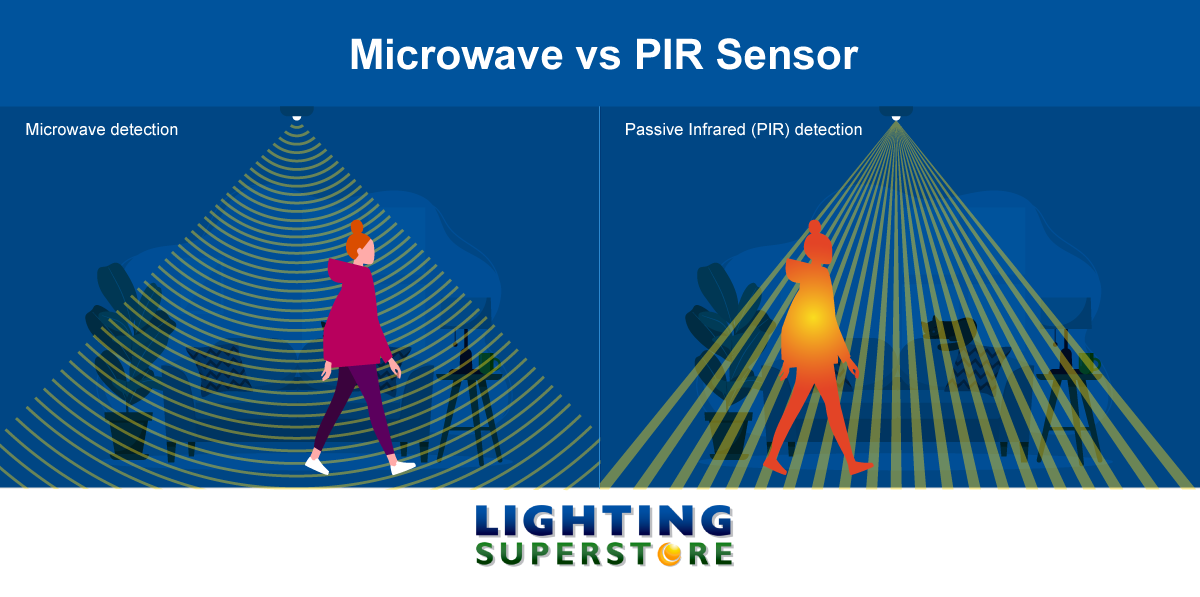Buyer’s Guide to Security Lights
Security lights give you peace of mind and are an effective deterrent for potential intruders.
There are a number of things to consider before buying though. It can depend on the size of your house or garden, your budget and what you need the lights for – a driveway, back garden, business or even something as big as a car park or stadium.
Read our guide on security lighting to help you decide the best lights for you. Then shop our range of security lights.
Types of security light
There are several types of security light – below is a rundown on the main four.
Solar Powered
These gather energy from the sun during the day to power up internal batteries, which power the lights. This means they don’t require power from the mains.
Solar security lights offer a cost-effective option that is also environmentally friendly. The biggest drawback to consider is the dimmer light they produce compared to other lights. Higher levels of air pollution make them less efficient, so keep that in mind too.
Floodlights
Floodlights are the most common security lights. They are versatile and are used for security in homes, – front and back – business, car parks and streets. Powerful enough to light up wide areas, they can be used to illuminate your whole driveway or garden, as well as car parks and even stadiums.
There are two main types of floodlights – halogen and LED.
LED – More powerful and cost efficient than halogen. They are designed to use far less power – LEDs can use up to 85% less energy than a halogen bulb to produce the same light. Although LED lights can save you a lot of money in the long run, the initial outlay will be considerably more than halogen alternatives.
Halogen – A cheaper alternative to LED. As halogen bulbs use far more power to run than LED, they produce lots of heat as a bi-product – this can sometimes cause them to burn out and even burst the bulbs. This is something to keep in mind if you plan on using them for long periods of time, as it can be a potential fire hazard.
Motion Sensor
- The best features of motion sensors are they are power saving and discrete – they won’t bother your neighbours as much as keeping a floodlight on all night. You can adjust the sensitivity settings so they will only trigger when needed – i.e., a potential intruder walks past and not just a leaf blowing in the wind. Another big plus is versatility.
You can use them in large properties and smaller terraced housing. They are perfect for giving you peace of mind, while not putting a strain on your wallet. There are three main mechanisms used for motion sensor lights: PIR, microwave, or hybrid sensors.

PIR (Passive Infrared Sensors)
This mechanism works by detecting changes in temperature – commonly caused by a human body passing through the sensor’s path. Human bodies give off a fair amount of heat, which is detected by PIR sensors. PIR lights include something called a Fresnel lens, which basically acts as an ‘amplifier’ for the PIR sensor, giving it a wider radius for detection.
Microwave
Microwave sensors work by sending out microwave radiation and detecting shifts in frequency, which are caused by movement. These frequency shifts trigger the sensor, turning on the light. The main advantage of microwave sensors over PIR is they cover a larger area, making them ideal for the security of larger properties, like office buildings.
Microwave sensors can penetrate walls, so if you have an awkward area to cover, with lots of obstructions, then microwave might be a better choice than PIR. However, due to this ability to detect movement through walls, microwave lights tend to cause a lot of ‘false alarms.’ Coupled with a large detection radius, this means they are not the best choice for smaller households in heavily built-up areas. Besides that, microwave sensors are generally more expensive than PIR lights as well.
Hybrid Sensors
Also known as dual tech, these are a combination of the two main mechanisms – PIR and microwave. To set off the light, both the microwave and PIR mechanisms must be triggered – this means a change in temperature and motion will need to occur. The best thing about this system is it results in a low number of false alarms.
Timer Activated
Some security lights are set to turn on and off automatically at specific times. With some lights you can set these manually yourself to cover a specific period of time. Other lights use a technology called photocell that detects changes in the levels of light. This allows the lights to be set to turn on when night falls and turn off again when the sun rises. Timer security lights are obviously less cost effective than others and are not well suited to homes in built-up areas with lots of neighbours close by.

